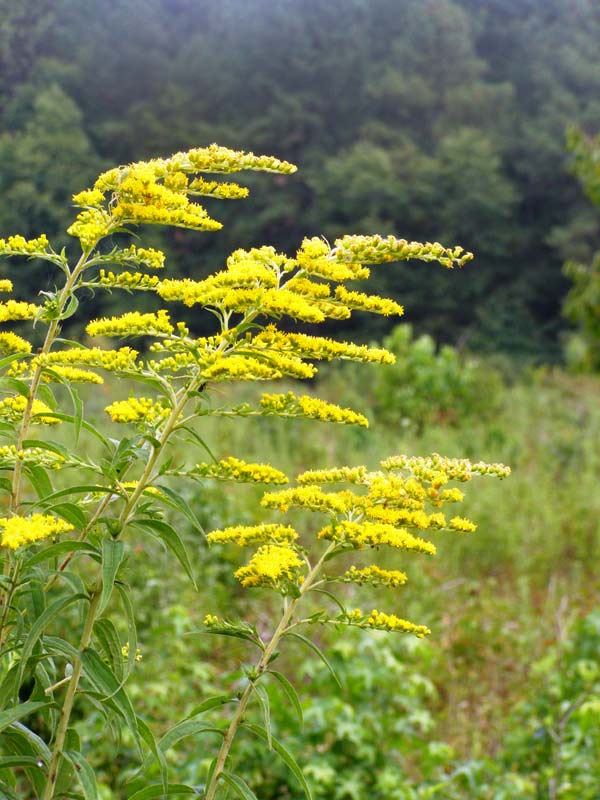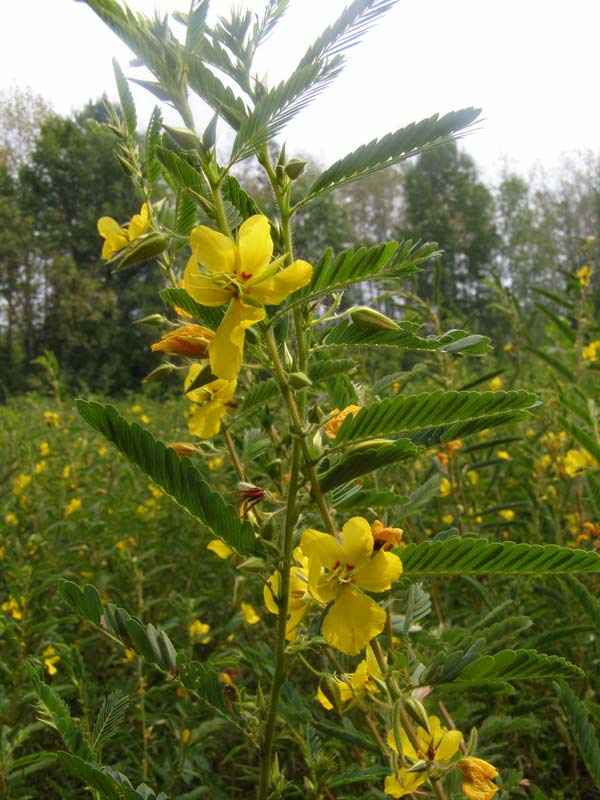
Of wildflowers and drought

Common Tall Goldenrod at Mason Farm Biological Reserve. Photo by Ken Moore
strong>By Ken Moore
Flora Columnist
Goldenrods – particularly the Pineywoods Goldenrod, Solidago pinetorum, a welcome sign of approaching fall – have begun coloring up the roadsides in spite of the drought. It was one of the first plants carried over to England, where it quickly became a standard flower of the famed perennial border and the English cottage garden. Some fine goldenrod cultivars have been produced by keen English gardeners and I remember walking into the Great Autumn Flower Show of the Royal Horticultural Society at Vincent Square in London in 1981 to see a magnificent tub of the tall, common goldenrod high up on the center display. Some folks may still consider goldenrod to cause hay fever. I may feature ragweed, the true hay fever plant, later on, but for now, trust me, you won’t get hay fever from sniffing goldenrod. You may get a bee or some other flying insect up your nose – for those colorful critters, not the wind, are necessary for transporting all that pollen from plant to plant!
We’ll be seeing goldenrods now for another two months. Of the more than 30 species native to North Carolina, there are two that represent the classic common Tall Goldenrod, standing 4–6 feet-plus, along roadsides and in fields throughout. One with glabrous (smooth) stems is an early bloomer, Solidago gigantea. It’s noticeable along some roadsides and in the fields of the Botanical Garden’s Mason Farm right now. The other has pubescent (fuzzy) stems and it flowers about a month later. It’s fun to enjoy a repeat performance at the Mason Farm with this second Solidago altissima. Goldenrods are generally available at the Totten Center and local garden centers for gardeners to establish in their own gardens. And some of you may have noticed that the goldenrod is frequently showing up in flower shops and expensive florists’ arrangements.
I enjoyed a walk around Mason Farm a few days ago and discovered that I had forgotten another of my favorite flowers of late summer, the bright mustard-yellow Partridge Pea, Cassia fasciculata (Chamaecrista fasciculate). In the fall, the two-inch-long pea pods snap, crackle and pop, catapulting their little brown beans far and wide. The little beans are considered a fine food for any remaining Bobwhite Quail that used to be so common out on the Farm.
There’s a whole field of it mixed in with another late-summer bloomer, Thoroughwort, Eupatorium serotinum, close kin to the Joe-Pye-Weed, Eupatorium fistulosum (Eupatoriadelphus fistulosus), and here and there a few stems of brilliant purple-flowered Ironweed, Vernonia noveboracensis. All these flowers were providing nectar for at least four different butterfly species fluttering over the whole wild banquet. Don’t know where the butterflies were obtaining their moisture since the ditches all around the Farm are very dry just now. It is so amazing how wild nature survives such harsh conditions.

Mustard yellow flowers of Partridge Pea at Mason Farm. Photo by Ken Moore
Another happy observation in this extreme drought is the continuing flowering of that common native vine, the Trumpet Creeper, Campsis radicans, that was in full flower back during the middle of June and continues to provide nectar for the hummingbirds preparing for their big journey south.
Some Water Strategies
I believe this drought is the most serious one in my lifetime, and I’m old enough for that to be really serious. Dying trees are making me think back to that April freeze. My several redbuds, Cersis canadensis, which nature planted, and my two pawpaws, Asimina triloba, which I planted, suffered greatly during that freeze. You will recall that many of the trees of our forests and roadsides suffered similar setbacks.
The second challenge of this extreme drought is simply too much; many plants won’t recover and we are witnessing the decline and death of many, many big ones. How I wish I could go water the forest, but only nature has that option.
My redbuds and pawpaws have crisp foliage and a few limbs are already dead to the main trunk. What green leaves are left seem to be hanging on with my cautious hand-watering from a well that will not tolerate unwise or wasteful use. I’m taking a big step back to consider which among the plants in my landscape are the really important ones. In addition to my little redbuds and pawpaws are two Southern Sugar Maples, Acer saccharum ssp. floridanum (Acer barbatum), a big one in the front transplanted from the woods back in 1939 when the house was built and a second smaller one that planted itself next to our deck and is now a welcome shade canopy. They’re holding up fine, but I’m watching them carefully and they’ll get my priority hand-watering when needed. With my limited water supply, I have to be philosophical when the flowers and shrubs I planted in well-prepared beds years ago are slowly dying. Curiously, many of the volunteer plants out in the unimproved yard are faring better.
Thankfully, my real gardening activity the past few seasons has been confined to containers of all sizes on and around the deck. In this water shortage, I have all the pots in large saucers and lots of them grouped together in several plastic kiddie wading pools. This way none of the water is wasted and I can go one or more days without watering.
I’ve always described that the only effective irrigation system is a thoughtful gardener on the end of a hose. When watering your landscape, consider that your most important plants are your big trees. If you have lots of trees, consider which ones you will be most unhappy to lose. Think of Weaver Street Market without its big trees. One of them now is downright dead. Look up into the branches to notice a few others in real decline. All those pattering feet on the root zone and no regular watering will eventually turn the Weaver Street gathering place into Weaver Street Beach. Sun worshipers will love it, but the rest of us will be seeking chairs under the side canopy.
When watering your trees, or any plants, make certain your application is slow, so that water doesn’t run off the surface, away from the root zone. Make certain water is getting down through any layer of mulch to actually penetrate the soil root zone. The general advice is to provide the equivalent of one inch of rain to the whole root zone on a weekly basis. And please be aware that the significant root zone of plants, especially mature trees, extends far beyond the canopy – i.e., the overhang of the tree branches – so that watering just at the base of a plant is not going to do it!
Rain barrels are a must. My three are empty right now, but they are so useful when filled. I need to install several more. It’s rewarding to discover how quickly a single barrel will fill during even a short shower. This is a resource well worth the cost and time to install. If you have the space, better yet, install a large cistern or two. Go look at the big one Bill Bracey has installed at Arbor Reality on Rosemary Street.
Email Ken Moore at flora@carrborocitizen.com.
Find more Ken Moore Citizen columns at The Annotated Flora
from → Ken Moore's Flora, Summer

Comments are closed.